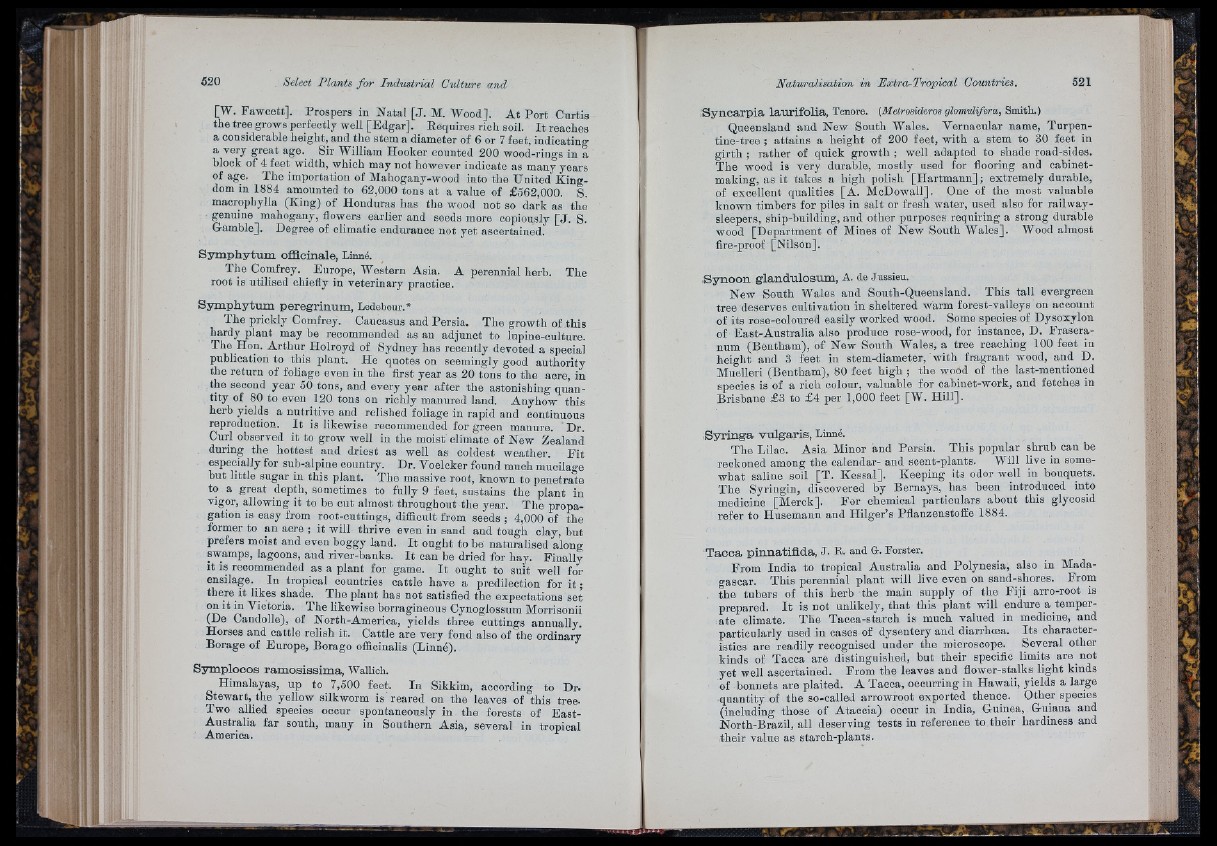
[W. Fawcett], Prospers in Natal [J . M. Wood], A t Port Curtis
the tree grows perfectly well [E d g a r]. Requires rich soil. I t reaches
a considerable height, and the stem a diameter of 6 or 7 feet, indicating
a very great age. Sir William Hooker counted 200 wood-rings in a
block of 4 feet width, which may not however indicate as many years
of age. The importation of Mahogany-wood into the United Kingdom
in 1884 amounted to 62,000 tons at a value of £562,000. S.
macropliylla (King) of Honduras has the wood not so dark as the
genuine mahogany, flowers earlier and seeds more copiously [ J . S.
Gamble]. Degree of climatic endurance not yet ascertained.
Symphytum officinale, Linné.
The Comfrey. Europe, Western Asia. A perennial herb. The
root is utilised chiefly in veterinary practice.
Symphytum peregrinum, Ledebour.*
The prickly Comfrey. Caucasus and Persia. The growth of this
hardy plant may be recommended as an adjunct to lupine-eulture.
The Hon. Arthur Holroyd of Sydney has recently devoted a special
publication to this plant. He quotes on seemingly good authority
the return of foliage even in the first year as 20 tons to the aere, in
the second year 50 tons, and every year after the astonishing quantity
of 80 to even 120 tons on richly manured land. Anyhow this
herb yields a nutritive and relished foliage in rapid and continuous
reproduction. I t is likewise reoommended for green manure. Dr.
Curl observed it to grow well in the moist climate of New Zealand
during the hottest and driest as well as coldest weather. F it
especially for sub-alpine country. Dr. Voelcker found much mucilage
but little sugar in this plant. The massive root, known to penetrate
to a great depth, sometimes to fully 9 feet, sustains the 'p lan t iu
vigor, allowing ii to be cut almost throughout the year. The propagation
is easy from root-cuttings, difldcult from seeds ; 4,000 of the
former to an acre ; it will thrive even iu sand and tough clay, hut
prefers moist aud even boggy land. I t ought to be naturalised along
swamps, lagoons, aud river-banks. I t can be dried for hay. Finally
it is recommended as a plant for game. I t ought to suit well for
ensilage. In tropical countries cattle have a predilection for i t ;
there it likes shade. The plant has not satisfied the expectations set
on it iu Victoria. The likewise borragineous Cynogiossum Morrisonii
(De Candolle), of North-America, yields three cuttings annually.
Horses and cattle relish it. Cattle are very fond also of the ordinary
Borage of Europe, Borago officinalis (Linné).
Symplocos ramosissima, Wallich.
Himalayas, up to 7,500 feet. In Sikkim, according to Dr*
Stewart, the yellow silkworm is reared ou the leaves of this tree.
Two allied species occur spontaneously in the forests of East-
Australia far south, many in Southern Asia, several in tropical
America.
S y n c a rp ia la u rifo lia , Tenore. (Metrosideros glomulifera, Smith.)
Queensland and New South Wales. Vernacular name, Turpen-
tine-tree ; attains a height of 200 feet, with a stem to 30 feet in
g irth ; rather of quick growth ; well adapted to shade road-sides.
The wood is very durable, mostly used for flooring and cabinet-
making, as it takes a high polish [Hartmann] ; extremely durable,
of excellent qualities [A. McDowall]. One of the most valuable
known timbers for piles in salt or fresh water, used also for railway-
sleepers, ship-building, and other purposes requiring a strong durable
wood [Department of Mines of New South Wales]. Wood almost
fire-proof [Nilson].
S y n o o n g la n d u lo sum , A. de Jussieu.
New South Wales and South-Queensland. This tall evergreen
tree deserves cultivation in sheltered warm forest-valleys on account
of its rose-coloured easily worked wood. Some species of Dysoxylon
of East-Australia also produce rose-wood, for instance, D. Frasera-
num (Bentham), of New South Wales, a tree reaching 100 feet in
height and 3 feet in stem-diameter, with fragrant wood, and D.
Muelleri (Bentham), 80 feet high ; the wood of the last-mentioned
species is of a rich colour, valuable for cabinet-work, and fetches in
Brisbane £3 to £4 per 1,000 feet [W. H ill].
Syring-a v u lg a r is , Linné.
The Lilac. Asia Minor and Persia. This popular shrub can be
reckoned among the calendar- and scent-plants. Will live in somewhat
saline soil [T. Kessal]. Keeping its odor well in bouquets.
The Syringin, discovered by Bernays, has been introduced into
medicine [Merck]. For chemical particulars about this glycosid
refer to Husemann aud Hilger’s Pflauzenstoffie 1884.
T a c o a p in n a tif ld a , J- B- and G. Forster.
From India to tropical Australia and Polynesia, also in Madagascar.
This perennial plant will live even on sand-shores. From
the tubers of this herb the main supply of the F iji arro-root is
prepared. I t is not unlikely, th a t this plant will endure a temperate
climate. The Tacca-starch is much valued in medicine, and
particularly used in cases of dysentery and diarrhoea. Its characteristics
are readily recognised under the microscope. Several other
kinds of Tacoa are distinguished, but their specific limits are not
yet well ascertained. From the leaves and flower-stalks light kinds
of bonnets are plaited. A Taoca, occurring in Hawaii, yields a large
quantity of tiie so-called arrowroot exported thence. Other species
(including those of Ataccia) occur in India, Guinea, Guiana and
North-Brazil, all deserving tests in reference to their hardiness and
their value as starch-plants.